Environment: milieu / climate zone / intervalo de profundidade / distribution range
Ecologia
marinhas; Água doce; estuarina bentopelágico; anfídromo (Ref. 46888); intervalo de profundidade 0 - 6 m (Ref. 90102). Tropical
Asia and Oceania: India, Hong Kong, Malaysia, Indonesia and Australia.
Tamanho / Peso / Idade
Maturidade: Lm ? range ? - ? cm
Max length : 10.0 cm SL macho/indeterminado; (Ref. 7050)
Espinhos dorsais (total) : 6 - 7; Raios dorsais moles (total) : 11 - 12; Espinhos anais: 1; Raios anais moles: 9 - 10. Characterized by pale grey to brownish body color grading to white on lower half; dark brown scale margins forming honeycomb pattern; presence of narrow dark brown to blackish stripe from rear edge of eye to above base of pectoral fin; dorsal and lower part of caudal fins with dark spotting; fully united pelvic fins with well developed frenum; rounded caudal fin, about equal to head length; longitudinal scale series 32-38; predorsal scales 12-16, reaching interorbital space; ctenoid body scales, becoming cycloid anterior to pectoral and pelvic fins; scales absent on cheek, 1-2 rows on anterodorsal part of operculum; depth of body 4.7-6.4 in SL (Ref. 90102).
Body shape (shape guide): elongated.
Inhabits sand or mud bottoms of estuaries and sheltered shoreline reefs in 0-6 m (Ref. 90102).
Life cycle and mating behavior
Maturidade | Reprodução | Desova | Ovos | Fecundidade | Larvas
Genital papilla of male sometimes heavily pigmented, reaching anal spine. Genital papilla of female truncate, ending well short of anal spine.
Kottelat, M., A.J. Whitten, S.N. Kartikasari and S. Wirjoatmodjo, 1993. Freshwater fishes of Western Indonesia and Sulawesi. Periplus Editions, Hong Kong. 221 p. (Ref. 7050)
Categoria na Lista Vermelha da IUCN (Ref. 130435: Version 2024-2)
Ameaça para o homem
Harmless
Utilização humana
Ferramentas
Relatórios especiais
Descarregue XML
Fontes da internet
Estimates based on models
Preferred temperature (Ref.
123201): 24.7 - 29.3, mean 28.6 °C (based on 2826 cells).
Phylogenetic diversity index (Ref.
82804): PD
50 = 0.5005 [Uniqueness, from 0.5 = low to 2.0 = high].
Bayesian length-weight: a=0.00724 (0.00339 - 0.01546), b=3.10 (2.92 - 3.28), in cm total length, based on LWR estimates for this (Sub)family-body shape (Ref.
93245).
Nível Trófico (Ref.
69278): 3.4 ±0.4 se; based on size and trophs of closest relatives
Resiliência (Ref.
120179): Elevada, tempo mínimo de duplicação da população menor que 15 meses (Preliminary K or Fecundity.).
Fishing Vulnerability (Ref.
59153): Low vulnerability (10 of 100).
🛈
Nutrients (Ref.
124155): Calcium = 292 [148, 635] mg/100g; Iron = 1.07 [0.55, 2.08] mg/100g; Protein = 16.9 [15.0, 18.5] %; Omega3 = 0.135 [0.046, 0.326] g/100g; Selenium = 28.5 [11.9, 64.1] μg/100g; VitaminA = 55.2 [16.3, 161.7] μg/100g; Zinc = 2.64 [1.80, 3.93] mg/100g (wet weight);
